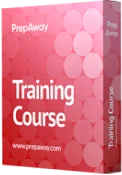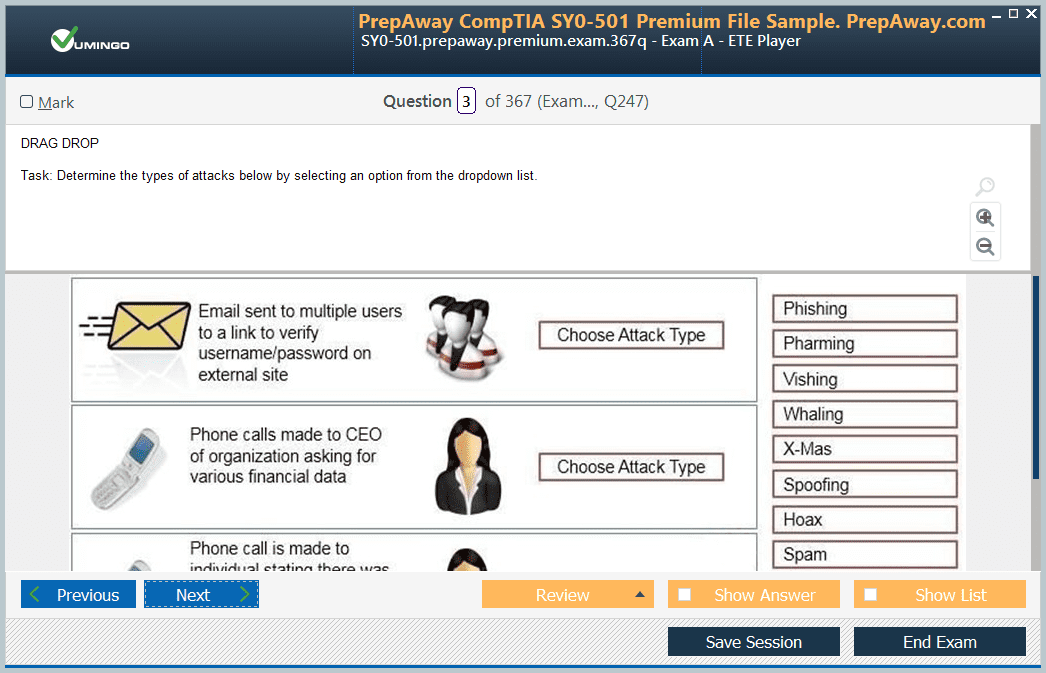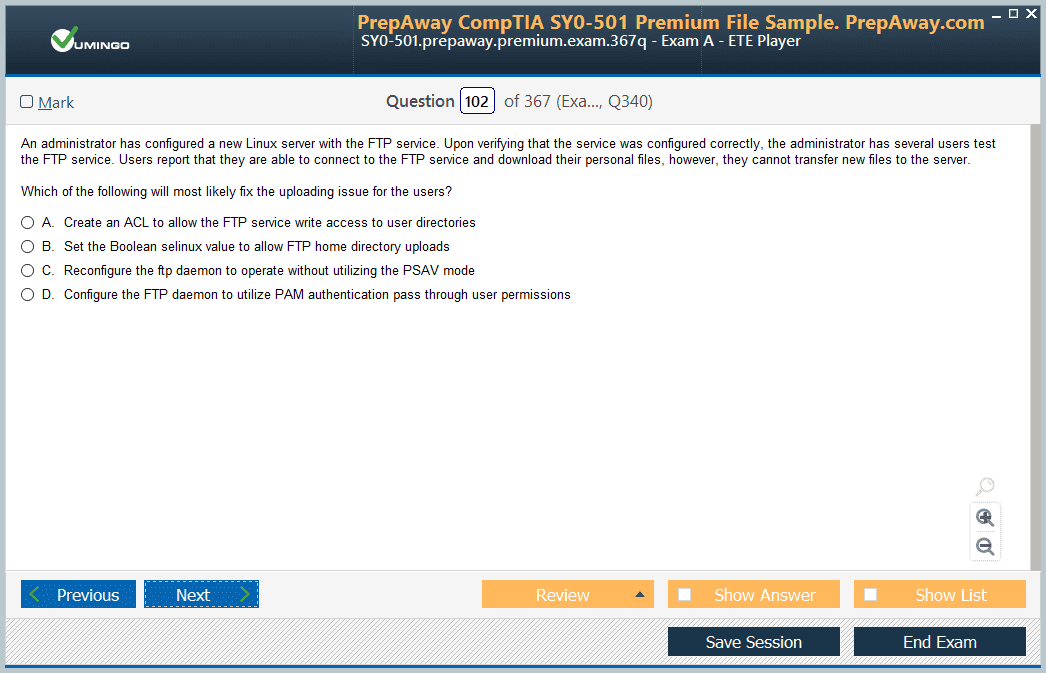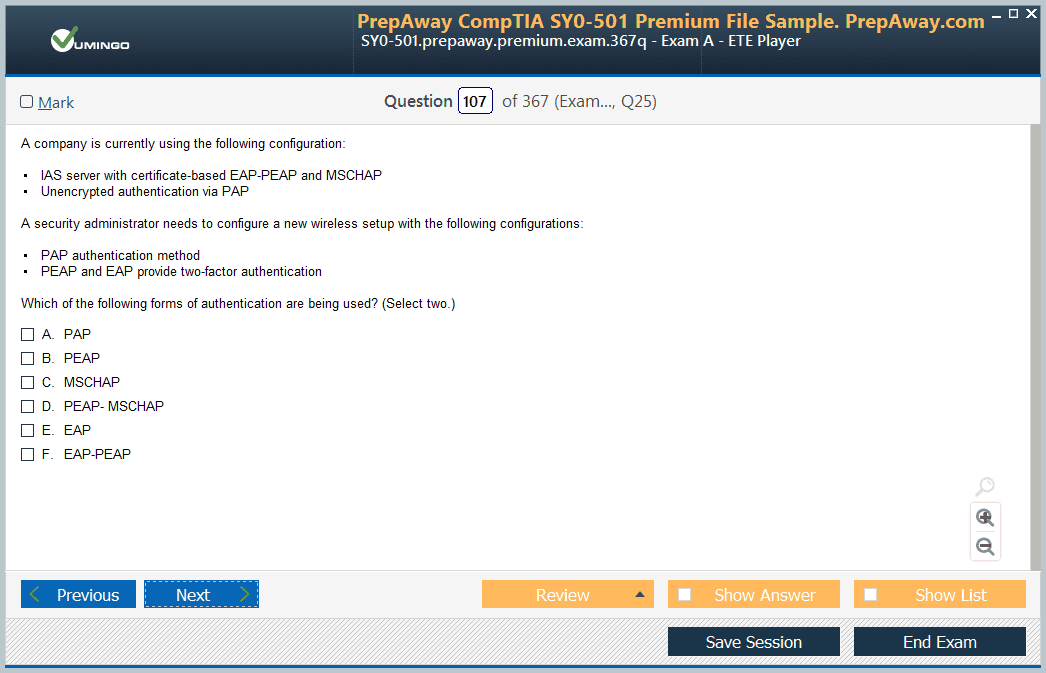- Home
- CompTIA Certifications
- XK0-005 CompTIA Linux+ Dumps
Pass CompTIA XK0-005 Exam in First Attempt Guaranteed!
Get 100% Latest Exam Questions, Accurate & Verified Answers to Pass the Actual Exam!
30 Days Free Updates, Instant Download!


XK0-005 Premium Bundle
- Premium File 477 Questions & Answers. Last update: Nov 28, 2025
- Training Course 145 Video Lectures
- Study Guide 1211 Pages
Last Week Results!

Includes question types found on the actual exam such as drag and drop, simulation, type-in and fill-in-the-blank.

Based on real-life scenarios similar to those encountered in the exam, allowing you to learn by working with real equipment.

Developed by IT experts who have passed the exam in the past. Covers in-depth knowledge required for exam preparation.
All CompTIA XK0-005 certification exam dumps, study guide, training courses are Prepared by industry experts. PrepAway's ETE files povide the XK0-005 CompTIA Linux+ practice test questions and answers & exam dumps, study guide and training courses help you study and pass hassle-free!
Terminal Skills Tested: What You Need to Know for XK0-005
CompTIA Linux+ certification is designed to validate an individual’s foundational skills in one of the most widely used operating systems in IT. Unlike vendor-specific qualifications, Linux+ is distribution-neutral and focuses on essential competencies that systems administrators and IT professionals need to manage Linux environments effectively. Earning this credential signals mastery of core topics such as system configuration, security, scripting, automation, and troubleshooting—all critical skills for careers in infrastructure, DevOps, and cloud administration.
Since Linux powers everything from servers to embedded systems and cloud platforms, having a recognized benchmark like Linux+ establishes your credibility as someone capable of administering real-world production environments. This certification is often a stepping stone toward more advanced, distribution-specific credentials.
Exam Details For XK0‑005
The current version, XK0‑005, reflects modern changes in enterprise environments. Here are the key details:
Number of questions: Up to 90
Time allowed: 90 minutes
Passing score: 720 out of 900
Format: Multiple-choice (single and multiple response) plus performance‑based questions
Cost: Approximately USD 390
This format blends theory with practical, screen-based simulations to test real-world abilities rather than rote memorization. The exam objectives are broken into major domains:
System management (32%)
Security (21%)
Scripting, containers, automation (19%)
Troubleshooting (28%)
Each domain covers essential tasks—from user and file management to scripting, basic container usage, securing systems, and diagnosing common Linux issues.
Deep Dive Into Exam Domains
System Management (32%)
This domain tests your ability to administer users and groups, manage permissions, configure system services, schedule routine jobs, and maintain system monitoring and logs. Common topics include configuring system localization, maintaining time synchronization, understanding kernel parameters, and using systemd or other init systems. You also need to be familiar with package managers for installations, updates, and patching across distributions.
Security (21%)
Security skills evaluated here include enforcing file and directory permissions, configuring sudo access, using encryption tools, and implementing basic firewall configuration. This domain also addresses secure user authentication practices, including managing SSH keys, configuring access controls, and understanding SELinux or AppArmor basics. Strong security fundamentals are critical, whether managing servers or locking down container hosts.
Scripting, Containers, And Automation (19%)
Candidates must demonstrate the ability to write basic shell scripts, schedule jobs with cron or systemd timers, and automate routine tasks. This domain also covers container concepts, such as building, running, and managing containers using tools like Podman or Docker, and understanding why containerization matters in modern Linux deployments. Familiarity with configuration automation tools or cloud‑focused scripting is an added plus.
Troubleshooting (28%)
This domain tests your ability to diagnose and resolve issues related to performance, network connectivity, system crashes, log analysis, and application failures. You should be adept at using tools like top, ps, netstat, journalctl, and dmesg. Scenario-based questions challenge you to interpret symptoms and propose corrective actions—skills essential during high-pressure support calls or production outages.
Why This Version Matters More Than Ever
The XK0‑005 version enhances the previous exam by placing increased weight on automation, scripting, container usage, and risk-aware security practices. This shift reflects changes in modern infrastructure management where containers and automation play central roles. Candidates learn not just how to operate Linux systems, but also how to automate deployment and secure workloads efficiently.
By mastering this newer version, individuals gain credentials aligned with current industry demands—and the ability to stand out in fields like cloud engineering, DevOps, and site reliability operations.
Key Skills You'll Learn Through Preparation
Preparing for XK0‑005 hones a variety of skills that extend beyond exam memorization:
How to customize shell environments and manage configuration files across login sessions
Scheduling jobs, managing system services, and automating backups
Writing basic scripts to improve efficiency and reduce manual effort
Administering containers, building images, and orchestrating deployments
Configuring firewalls, securing file systems, and auditing user activity
Identifying root causes of performance issues, network failures, or service crashes
These competencies have practical relevance beyond certification and build a solid foundation for advanced roles in system and cloud administration.
Building A Preparation Strategy For The Linux+ XK0-005 Exam
Passing the Linux+ XK0-005 exam requires more than technical knowledge. A well-structured preparation plan is essential to ensure your efforts are consistent and focused on the exam domains. Unlike more theoretical exams, this certification tests your ability to perform tasks in real-world Linux environments. Preparing for it requires discipline, hands-on experience, and ongoing assessment.
Start by examining the exam objectives. Identify which areas are already familiar to you and which ones require deeper study. Build a calendar that includes daily or weekly learning goals. Divide your time across the exam domains so you give adequate attention to both your strengths and weaknesses. Remember, managing your time is part of the discipline that this certification indirectly evaluates.
Understanding The Linux Operating System Inside Out
One of the most valuable aspects of preparing for this exam is learning the internal workings of Linux systems. Understanding Linux is not just about knowing commands. You should know why certain commands exist, what processes are running behind them, and how these processes interact with hardware and software.
System management tasks such as configuring network interfaces, managing systemd units, and monitoring performance give insights into the Linux operating system’s core mechanisms. When studying file systems, explore how different types of file permissions work, what happens when files are deleted, and how the Linux kernel manages resources.
Spend time analyzing log files and system outputs. Look at how system booting works, from BIOS and GRUB to kernel initialization. Try reproducing basic boot failures in a virtual machine to understand recovery procedures. This will build a deeper understanding and make troubleshooting much more intuitive.
Practicing With Shell Scripting And Command Line Skills
Command line knowledge is vital for success in Linux environments. The XK0-005 exam places a strong emphasis on scripting and command execution. Begin by getting comfortable with common command line utilities such as grep, awk, sed, find, cut, and xargs. These tools help process logs, manage files, and automate routine tasks.
Start writing basic scripts using bash. Learn how to declare variables, use conditionals, implement loops, and manipulate text. Gradually move on to intermediate tasks like automating backups, creating user management scripts, and scheduling tasks with cron.
Test your scripts regularly and debug them when they fail. Avoid copying code without understanding it. Knowing how to write a script that creates a new user or cleans temporary files shows your ability to think like a Linux administrator. During the exam, this skill helps you approach practical scenarios with confidence.
Developing Proficiency In Linux Services And Configuration Files
Another critical part of preparation is understanding how Linux services operate. Whether configuring SSH, scheduling tasks, or deploying web services, most of your work revolves around modifying configuration files. Learn how services are enabled, started, stopped, and monitored using system tools.
Explore the structure of configuration files in /etc. Study how permissions and ownership influence file behavior. Try modifying default configurations to understand how Linux reacts to changes. Learn to restart services safely and read service logs for errors.
Practice setting up a basic web server or configuring a local DNS resolver. These small projects reinforce learning while giving you the troubleshooting experience necessary to diagnose problems under pressure. Even setting up a print server or local mail relay helps bridge knowledge gaps about communication protocols.
Building Familiarity With Linux Security Practices
Security is more than just protecting files. In the Linux environment, it’s about preventing unauthorized access, controlling user privileges, and managing system integrity. The XK0-005 exam expects candidates to understand user authentication mechanisms, firewalls, encryption, and access control techniques.
Begin by learning how to configure user accounts securely. Study how to restrict user access using file permissions, sudo configuration, and user groups. Explore how to create and manage SSH keys and disable root login for better security.
Set up a firewall using tools like firewalld or iptables and practice creating rules that control inbound and outbound traffic. Understand how Linux implements encryption at rest and in transit. Use tools like GPG and OpenSSL to experiment with data encryption.
Explore access control systems like SELinux or AppArmor. You don’t need to be an expert in these, but understanding their role in restricting processes will be helpful. Security is a thread that runs through every part of the exam, so don’t isolate it as a separate subject.
Gaining Practical Experience Through Hands-On Labs
Studying theory is important, but it cannot substitute for practical experience. Set up a virtual lab using virtualization software to run Linux distributions like Ubuntu, CentOS, or AlmaLinux. Create multiple virtual machines to simulate networks and test different configurations.
In your lab environment, experiment with installing packages, creating users, setting permissions, and configuring services. Break your system on purpose and try to fix it. Recovering from failures teaches more than any textbook.
Try projects like configuring a mail server or setting up automated monitoring tools. These experiences create muscle memory that will help you answer performance-based exam questions quickly. Practical exposure also builds your confidence in solving problems that look complex but are grounded in familiar tasks.
Reviewing Weak Areas And Filling Knowledge Gaps
At a certain point in your preparation, you should be able to identify the domains where you consistently struggle. For some, scripting might be difficult. Others may find system boot processes confusing. This is where targeted review becomes essential.
Break down complex topics into smaller components. For example, if you struggle with networking, focus first on the basics like IP addressing and routing, then move on to services like DHCP and DNS. Use command line tools to check connectivity, inspect routing tables, and analyze port usage.
Regularly reviewing weak areas prevents panic during the exam. Don’t skip topics that feel boring or complex. Often, these are the ones that appear unexpectedly in the exam and throw candidates off balance.
Assessing Your Readiness With Practice Sessions
Assessing your readiness is not about scoring high on a test. It’s about evaluating how quickly and accurately you can solve a problem. Time yourself while solving exercises. Try simulating a full 90-minute session with a mix of conceptual and performance-based tasks.
Track your improvement over time. Review mistakes carefully and understand why you chose the wrong answer. Was it a misinterpretation, lack of knowledge, or a simple oversight? Fixing these patterns will save you valuable points in the actual exam.
Challenge yourself by solving open-ended questions. Try to answer, “How would I troubleshoot a system that is not connecting to the network?” or “How would I automate the creation of ten users with unique passwords?” These questions don’t come with answer keys but are invaluable in preparing you to think critically during the exam.
Creating Study Materials For Quick Revision
During preparation, create your own set of notes. Focus on command usage, configuration files, system behaviors, and problem-solving steps. Writing notes helps reinforce memory. They also provide a quick reference in the days before the exam.
Highlight commands that you often forget or configuration file paths that require memorization. Include key flags for commonly used tools like tar, grep, systemctl, and chmod. Organize your notes by domain or task category so you can revisit specific sections as needed.
Use diagrams to visualize file system hierarchies, boot sequences, or network interfaces. Some learners retain concepts better when they are represented visually. If that applies to you, sketch out complex ideas for better understanding.
Building Mental Readiness For The Linux+ XK0-005 Exam
Preparing technically is only part of the challenge. Success in the Linux+ exam also depends on mental readiness. Being calm and confident during the test helps reduce mistakes and improves your ability to think clearly under pressure. The exam will test not only your knowledge but your ability to remain composed and methodical.
Start by creating a calm study environment where you can focus. Avoid multitasking. Train your brain to stay locked on solving Linux-related problems for longer periods. Practice this by taking mock tests in quiet, uninterrupted settings. Gradually increase the length of study sessions to build mental endurance.
Equally important is having a positive mindset. Avoid thoughts like “this is too hard” or “I will probably fail.” Instead, reinforce your preparation by reminding yourself of the progress you have made. Every skill you develop adds to your confidence, and every mistake is a learning opportunity.
Simulating The Exam Day Experience
Simulating exam conditions is one of the most effective ways to prepare for the actual day. Time management is crucial during the Linux+ test. With only 90 minutes to complete up to 90 questions, every second matters. You cannot afford to dwell on a single question for too long.
Choose a day during your preparation to mimic the real exam. Find a quiet room, set a timer, and take a full-length practice test without pausing. Do not use any notes or external help. After completing it, analyze how you performed under pressure. Were there questions you wasted time on? Did you feel rushed toward the end?
This experience helps you develop a personal strategy. For example, you might decide to answer all the easy questions first, mark the difficult ones for review, and return to them later. This technique can prevent panic and help maintain momentum.
Knowing The Question Types And What To Expect
The Linux+ XK0-005 exam contains a mix of multiple-choice and performance-based questions. Understanding what each type demands can improve your efficiency. Multiple-choice questions test your theoretical understanding, while performance-based questions simulate real-world scenarios where you must solve tasks.
A performance-based question might ask you to troubleshoot a misconfigured system, modify a script, or implement a security policy. You could be presented with a Linux command line and asked to perform specific actions. These questions test not only knowledge but speed and accuracy.
Familiarize yourself with these formats before exam day. Practice typing commands quickly and accurately. Learn to read questions carefully and extract only the information you need. Avoid overanalyzing and second-guessing. Trust your instincts if you’ve prepared thoroughly.
Understanding How The Scoring System Works
The passing score for the Linux+ XK0-005 exam is 720 out of 900. This does not mean you need to answer 80 percent of the questions correctly, as not all questions are weighted equally. Some may carry more points than others, especially the performance-based ones.
You are not penalized for wrong answers, so it's better to attempt every question. Even if unsure, use the process of elimination. Remove obviously incorrect options, then make an informed guess. Never leave any question blank.
The exam may also include a few unscored questions that are used for research purposes. These questions do not affect your score, but you will not know which ones they are. This reinforces the importance of treating every question seriously and giving it your best attempt.
Preparing For The Unexpected
No matter how well you prepare, surprises can occur. You may encounter a question on a topic you barely remember or a command you’ve never used. What matters is how you respond in that moment. Panicking will only make things worse.
If a question confuses you, do not dwell on it. Mark it for review and move on. Often, later questions might trigger a memory or understanding that helps you return with fresh perspective. Maintain control of your emotions and stick to your time strategy.
Technical problems are rare but possible in digital exams. If something goes wrong, stay calm and inform the testing center staff. Having a composed and patient mindset will help you navigate any setbacks smoothly.
What To Bring And Expect At The Testing Center
Knowing what to bring and expect at the testing center removes unnecessary stress. You will need a valid, government-issued ID. Arrive early to allow time for check-in procedures. Personal belongings like phones and bags are usually not allowed inside the exam room.
You may be provided with a digital notepad or physical scratch paper depending on the test center. Use this to jot down ideas, command sequences, or steps during performance-based questions. Practice doing this during your prep so it feels natural during the real exam.
Dress comfortably and eat a light meal beforehand. Avoid caffeine if it makes you jittery. The goal is to be physically comfortable so your brain can work at full capacity during the test.
Staying Updated With Current Linux Practices
The Linux ecosystem evolves quickly. New distributions, tools, and features appear regularly. The Linux+ certification focuses on current technologies, so it's essential to stay updated with real-world practices. Follow updates to common tools and utilities. Learn the default behaviors in widely used distributions.
Spend time reviewing recent changes to systemd, newer versions of bash, or common automation tools. Try out tools like systemctl, journalctl, and netplan. Learn about modern package managers and how dependency management works.
Understanding current practices helps you answer questions in a way that aligns with real-world expectations. It also prepares you for practical roles that go beyond certification.
Connecting Concepts Across Exam Domains
The Linux+ XK0-005 exam does not test knowledge in isolated silos. Many questions require you to integrate concepts across multiple domains. For example, troubleshooting a service might involve networking, permissions, and scripting.
When you study, try to understand how topics interconnect. See how system management is tied to security, or how automation scripts can assist in routine troubleshooting. This approach builds a comprehensive understanding that not only helps in the exam but also in real-world job performance.
Practicing scenarios where multiple components interact helps you become more intuitive and adaptive. You begin to recognize patterns and think more like a systems administrator.
Using Visualization And Memory Techniques
Retention is key during exam preparation. Techniques like visualization can help reinforce concepts. For instance, draw diagrams of system architecture, network setups, or Linux boot sequences. These visuals stay longer in memory and are easy to recall under pressure.
Use memory tricks like acronyms, word associations, or even rhymes to remember complex commands or configuration options. Repetition also helps. Review your notes frequently and test yourself with flashcards or quizzes. Explain concepts out loud, even if studying alone. Teaching is a powerful way to reinforce your own learning.
Staying Motivated During The Final Days
The last few days before the exam are crucial. Many candidates experience a dip in energy or motivation. This is normal but must be managed. Remind yourself why you began this journey. Think about the skills you've gained and the opportunities that await.
Avoid cramming in the final hours. Use this time to relax your mind and go over high-level summaries or your personalized notes. Focus on clarity, not intensity. A well-rested mind will outperform an overworked one.
Visualize exam day positively. Picture yourself entering the room calmly, answering questions with focus, and walking out confidently. This mental rehearsal can reduce anxiety and reinforce your readiness.
Understanding The Importance Of Certification After The Exam
Earning the Linux+ XK0-005 certification marks a significant milestone in your IT career. It proves that you have solid, practical knowledge of Linux systems and are ready to handle real-world challenges. However, passing the exam is not the end but rather the beginning of a journey toward mastering Linux and expanding your professional opportunities.
Certification provides credibility with employers and peers. It differentiates you from non-certified professionals and often opens doors to job interviews, promotions, or higher pay. The skills validated by the certification are highly sought after in industries relying on Linux servers, cloud infrastructure, and containerization technologies.
Once certified, you will find many avenues to continue your learning. Keeping your skills updated and expanding into related areas will maximize the value of your investment in the XK0-005 exam.
Planning Your Career Path With Linux+ Certification
With your Linux+ certification in hand, consider how it fits into your long-term career goals. The certification prepares you for entry to mid-level Linux system administration roles. These include positions such as system administrator, junior Linux engineer, or operations analyst.
Evaluate where you want to specialize. Linux skills are in demand in fields such as cloud computing, cybersecurity, automation, and DevOps. Each area requires additional knowledge but starts with a strong Linux foundation. You might choose to focus on managing Linux servers in the cloud, securing systems, or building automation pipelines.
Use the Linux+ certification as a launching pad to target roles that align with your interests. Employers often value candidates who show commitment to continuous learning and professional growth. Your next steps could include certifications that focus on security, advanced scripting, or distribution-specific expertise.
Leveraging Your Certification To Gain Practical Experience
After passing the exam, gaining real-world experience is critical to cement your skills. Look for opportunities in your current job to apply Linux knowledge in daily tasks. Volunteer for projects that involve server setup, scripting automation, or system troubleshooting.
If you are new to the industry, consider setting up your own lab environment to simulate business scenarios. Practice installing, configuring, and securing servers. Experiment with container technologies like Docker or orchestration tools like Kubernetes, which are becoming standard in Linux ecosystems.
Hands-on experience not only reinforces what you learned for the exam but also prepares you for advanced responsibilities. It also boosts your confidence when speaking to potential employers or clients about your capabilities.
Continuing Education And Advanced Certifications
Linux is a vast and evolving ecosystem. After Linux+ XK0-005, consider pursuing advanced certifications to deepen your knowledge. Options include certifications that focus on security, cloud platforms, or specific Linux distributions like Red Hat or SUSE.
Advanced certifications typically build upon the skills validated by Linux+. For example, a security-focused certification dives deeper into Linux firewall configurations, intrusion detection, and secure system administration. Cloud-related certifications emphasize Linux in virtualized and containerized environments.
Choosing the right advanced certification depends on your career goals and interests. Research industry trends to see which skills are growing in demand. Continuous learning keeps your skills relevant and expands your professional network.
Networking With Linux Professionals And Communities
Joining professional Linux communities is an excellent way to continue learning and stay updated. These groups offer forums, meetups, and conferences where you can exchange ideas, solve problems, and hear about new technologies.
Engage actively in discussion boards, attend webinars, and contribute to open source projects. These activities help you build a reputation and gain practical insights beyond formal training.
Networking also opens doors to job opportunities, mentorship, and collaboration on complex projects. Connecting with experienced professionals helps you understand real-world applications of Linux knowledge and career pathways others have taken.
Building A Portfolio To Showcase Your Skills
A strong portfolio can demonstrate your Linux capabilities to employers better than a resume alone. Document projects that show your practical skills, such as setting up a web server, automating backups, or securing a system.
Use screenshots, command logs, and brief descriptions to explain your work. Include scripts you have written and explain their purpose and impact. Hosting your portfolio on a personal website or repository platform helps recruiters review your work easily.
This portfolio also serves as a personal archive of your progress. Over time, updating it with new projects reflects your growth and readiness for advanced roles.
Applying Linux Skills To Emerging Technologies
Linux forms the backbone of many modern technologies like cloud computing, containers, and automation. After certification, explore how Linux integrates with these fields to remain competitive.
For instance, containerization with Docker and orchestration using Kubernetes rely heavily on Linux namespaces and cgroups. Learning these technologies builds on the Linux foundation and opens job opportunities in DevOps and cloud-native development.
Automation tools like Ansible or Puppet allow administrators to manage Linux environments at scale. Mastering these tools increases efficiency and is highly valued by employers managing large infrastructures.
Exploring these technologies broadens your skill set and ensures you stay relevant as IT environments evolve.
Understanding The Value Of Soft Skills Alongside Technical Knowledge
While technical skills are critical, soft skills significantly impact your effectiveness as a Linux professional. Communication skills enable you to work with team members, document procedures, and explain technical problems clearly.
Problem-solving mindset and adaptability are vital when troubleshooting complex Linux systems. The ability to learn new tools quickly and handle unexpected issues distinguishes great administrators from average ones.
Time management helps you balance routine maintenance with urgent fixes. Leadership skills become important as you advance to roles involving team coordination or project management.
Developing these soft skills alongside your Linux expertise increases your value in any organization and prepares you for future leadership roles.
Maintaining Your Certification And Continuing Professional Growth
CompTIA certifications typically require renewal every three years. To maintain your Linux+ certification, you must complete continuing education activities such as earning higher certifications, participating in industry events, or contributing to Linux projects.
Stay committed to lifelong learning. The Linux landscape changes rapidly, and staying current benefits your career and employers alike.
Create a personal development plan that includes regular skill upgrades, certification renewals, and engagement with new technologies. Setting goals and tracking progress motivates consistent growth and helps you adapt to changing industry demands.
Leveraging Linux+ Certification To Explore Related IT Fields
Linux skills are highly transferable across IT domains. With a solid Linux foundation, you can transition into roles like cloud engineering, cybersecurity analyst, or automation engineer.
For example, many cloud platforms run Linux servers, so administrators are needed to manage these environments. Cybersecurity professionals use Linux tools for penetration testing and system hardening.
Learning scripting languages such as Python or Ruby complements your Linux skills and enables automation and integration tasks.
Expanding into related fields diversifies your career options and increases job security in a competitive job market.
Final Thoughts
Passing the Linux+ XK0-005 exam is a commendable achievement and a gateway to many opportunities. The certification validates that you understand Linux fundamentals deeply and are prepared to handle system administration tasks confidently.
However, the IT industry is ever-changing. Continuous learning, practical experience, and networking form the pillars of ongoing success. Use your certification as a foundation to build a rewarding career, exploring new technologies and roles that excite you.
Remember that Linux skills are in high demand worldwide, and your certification can open doors to global opportunities. Stay curious, stay motivated, and embrace the challenges ahead.
CompTIA XK0-005 practice test questions and answers, training course, study guide are uploaded in ETE Files format by real users. Study and Pass XK0-005 CompTIA Linux+ certification exam dumps & practice test questions and answers are to help students.
- SY0-701 - CompTIA Security+
- N10-009 - CompTIA Network+
- CS0-003 - CompTIA CySA+ (CS0-003)
- CAS-005 - CompTIA SecurityX
- 220-1201 - CompTIA A+ Certification Exam: Core 1
- PT0-003 - CompTIA PenTest+
- 220-1202 - CompTIA A+ Certification Exam: Core 2
- CV0-004 - CompTIA Cloud+
- PK0-005 - CompTIA Project+
- XK0-005 - CompTIA Linux+
- 220-1101 - CompTIA A+ Certification Exam: Core 1
- 220-1102 - CompTIA A+ Certification Exam: Core 2
- SK0-005 - CompTIA Server+ Certification Exam
- XK0-006 - CompTIA Linux+
- DA0-001 - Data+
- FC0-U71 - CompTIA Tech+
- CA1-005 - CompTIA SecurityX
- DS0-001 - CompTIA DataSys+
- CV0-003 - CompTIA Cloud+
- CAS-004 - CompTIA Advanced Security Practitioner (CASP+) CAS-004
- PT0-002 - CompTIA PenTest+ Certification Exam
- DY0-001 - CompTIA DataX
- CY0-001 - CompTIA SecAI+ Beta
- FC0-U61 - CompTIA IT Fundamentals
- CNX-001 - CompTIA CloudNetX
Purchase XK0-005 Exam Training Products Individually



Why customers love us?
What do our customers say?
The resources provided for the CompTIA certification exam were exceptional. The exam dumps and video courses offered clear and concise explanations of each topic. I felt thoroughly prepared for the XK0-005 test and passed with ease.
Studying for the CompTIA certification exam was a breeze with the comprehensive materials from this site. The detailed study guides and accurate exam dumps helped me understand every concept. I aced the XK0-005 exam on my first try!
I was impressed with the quality of the XK0-005 preparation materials for the CompTIA certification exam. The video courses were engaging, and the study guides covered all the essential topics. These resources made a significant difference in my study routine and overall performance. I went into the exam feeling confident and well-prepared.
The XK0-005 materials for the CompTIA certification exam were invaluable. They provided detailed, concise explanations for each topic, helping me grasp the entire syllabus. After studying with these resources, I was able to tackle the final test questions confidently and successfully.
Thanks to the comprehensive study guides and video courses, I aced the XK0-005 exam. The exam dumps were spot on and helped me understand the types of questions to expect. The certification exam was much less intimidating thanks to their excellent prep materials. So, I highly recommend their services for anyone preparing for this certification exam.
Achieving my CompTIA certification was a seamless experience. The detailed study guide and practice questions ensured I was fully prepared for XK0-005. The customer support was responsive and helpful throughout my journey. Highly recommend their services for anyone preparing for their certification test.
I couldn't be happier with my certification results! The study materials were comprehensive and easy to understand, making my preparation for the XK0-005 stress-free. Using these resources, I was able to pass my exam on the first attempt. They are a must-have for anyone serious about advancing their career.
The practice exams were incredibly helpful in familiarizing me with the actual test format. I felt confident and well-prepared going into my XK0-005 certification exam. The support and guidance provided were top-notch. I couldn't have obtained my CompTIA certification without these amazing tools!
The materials provided for the XK0-005 were comprehensive and very well-structured. The practice tests were particularly useful in building my confidence and understanding the exam format. After using these materials, I felt well-prepared and was able to solve all the questions on the final test with ease. Passing the certification exam was a huge relief! I feel much more competent in my role. Thank you!
The certification prep was excellent. The content was up-to-date and aligned perfectly with the exam requirements. I appreciated the clear explanations and real-world examples that made complex topics easier to grasp. I passed XK0-005 successfully. It was a game-changer for my career in IT!












